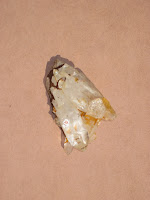I have a geode-themed entry this time! (One of my favorites!) Specifically, opening geodes. The trick is not to shatter it and to get as clean a cut as possible. To show you an example, I bought a break-your-own geode and took some photos as I broke it open.
 The first images are me (and my funny-looking safety goggles!) and my dad, TRYING to get the geode open with the Dremel. Most common geodes are about a 7 on Moh's hardness scale, like quartz, agate and amethyst. But it matters even more how dense it is, because it is really hard to open a geode of solid quartz with a thin, metal blade. Since diamond is a 10 on the hardness scale, people use diamond-edged cutters to slice really hard materials, like blocks of steel.
The first images are me (and my funny-looking safety goggles!) and my dad, TRYING to get the geode open with the Dremel. Most common geodes are about a 7 on Moh's hardness scale, like quartz, agate and amethyst. But it matters even more how dense it is, because it is really hard to open a geode of solid quartz with a thin, metal blade. Since diamond is a 10 on the hardness scale, people use diamond-edged cutters to slice really hard materials, like blocks of steel. We couldn't cut through the geode with the Dremel, so we scored it as much as we could with the Dremel, hoping it would be enough. Then, we took a risk: "the hammer job!" We hacked away with our hammer. The first couple whacks didn't even leave an impression. I could have thrown it at the ground all day, and it wouldn't have done anything. But finally, we got it open, and it was a fairly clean cut all the way through.
When I looked inside, I realized it had been worth the trouble - a milky, blue agate crystal, but nothing else. Just solid crystal. I was pleased.
Not all geodes are that hard to open; I just decided to get a really heavy one. Try to get a geode that's a little heavy for it's size, but not too heavy. If you want a nice geode that you'll be satisfied with, I recommend an average weight geode, so it isn't pitiful, with three microscopic crystals inside (those do exist, by the way!). Also, don't get one that's very heavy, or it will take hours to open, and you risk shattering it.
There are two ways that geodes are formed: volcanic and mineral-formed. The volcanic is made up of igneous rock that formed and air pocket before it solidified, and crystals grew inside of it. The mineral-formed geodes are normally quartz and agate - also created in air pockets - but with the help of water. Air pockets are first formed by the water flowing through the ground through erosion. An empty, hollow space is made. Over time, minerals build up from the water flowing as they are filted by the rock around the air pocket. They build up inside and form crystals. I haven't learned yet how to tell which was a geode has been formed by just looking at it. I do know that it takes a much longer time to make large crystals.
Below is an image of some other geodes in my collection.
 |
| Clockwise from Top Left: Quartz, Calcite, Amethyst, Thunder Egg |












